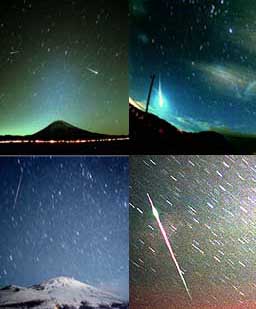Thousands of shooting stars provided a dazzling light show Sunday that amazed veteran and novice stargazers alike as the Leonid meteor shower made the moonless sky appear to rain light. At the peak of the early morning shower, as many as 1,250 meteors per hour streaked overhead.  About 150 Chinese who gathered at midnight on the roof of a 550-year-old Ming Dynasty stone observatory in Beijing were overjoyed when the first meteor tore across the sky leaving an ephemeral fiery trail in its wake. About 150 Chinese who gathered at midnight on the roof of a 550-year-old Ming Dynasty stone observatory in Beijing were overjoyed when the first meteor tore across the sky leaving an ephemeral fiery trail in its wake.
``There are many more shooting stars than I expected, and they're really clear,'' said a 19-year-old construction engineering student. Atop Mount Wilson (U.S.), hundreds of cars clogged the road leading to the observatory as stargazers sought out dark spots to watch the display. Patty Ronney, 49, said she had never seen a single meteor before leaving home. Streak after streak of light shot across the sky as tiny bits of comet debris burned up harmlessly in the atmosphere. The brightest flares left shimmering, smoky trails that hung in the sky for a few seconds. Clear skies also rewarded more than 1,000 stargazers who sat on lawn chairs at a youth training camp near Seoul, South Korea. The Leonid shower occurs each November, when the Earth's orbit takes it through the trail of particles shed by the Comet Tempel-Tuttle as it swings around the sun once every 33 years. Most particles are smaller than a grain of rice. They enter our atmosphere traveling 45 miles a second and burn up in brilliant streaks of light. The meteors are called Leonids because they appear to come from the direction of the constellation Leo. The last major Leonid shower occurred in 1966, when stargazers counted as many as 150,000 meteors per hour. Astronomers expect another such shower in 2099. Comets are believed to contain pristine examples of the materials that coalesced 4.5 billion years ago to form our solar system. The frozen balls of ice and debris are rich with basic elements like iron, as well as carbon-based molecules. (Agencies) | 11月19日凌晨狮子座流星雨如期而至,成千上万颗流星将晴朗的夜空照耀的无比灿烂,让新老天文爱好者叹为观止。 在这场流星雨的高峰阶段,空中划过的流星达到每小时1250颗之多。 在中国,约有150名天文爱好者聚集在北京一个有550年历史的明代天文台的屋顶上等待一睹流星雨的风采。当第一颗流星拖着火红的尾巴划破夜空时,人们不禁欣喜若狂。 一名19岁的建筑工程系的学生说:"天空中出现的流星比我预想的要多,而且肉眼看得非常清楚。" 在美国,通往威尔逊山顶上天文台的山路被 "追星族"的车子堵塞了。人们纷纷寻找昏暗的观测地点以便更好的欣赏流星雨。 49岁的帕蒂-龙尼说她在离开家赶到威尔逊山之前,从来没有见到过流星。 无数的彗星碎片在大气中燃烧,于是人们看到了一颗颗流星从空中划过的壮观景象,这些体积不大的彗星碎片的燃烧不会给人类带来灾难。那些最亮的流星拖着闪耀的气状慧尾划过空中,持续时间长达数秒钟。 在晴朗的夜空下,韩国汉城一个青年训练营中1000多名天文观测者也坐在草坪上的长椅上,尽情欣赏了这一难得的天文景观。 狮子座流星雨在每年的11月份出现一次。当地球穿过"坦佩尔-塔特尔"彗星尾部稠密的彗星碎片带时,就会出现流星雨现象。这颗彗星在太阳系外围轨道运行,它的运行周期是33年。 大部分彗星碎片大小还不及一粒大米。这些碎片以每秒钟45英里的速度穿过地球大气层,与大气层摩擦燃烧,在天空中留下一道道耀眼的光亮。这些流星之所以被命名为"狮子座流星",是因为它们是从狮子星座的方向飞来的。 最近一次规模较大的狮子座流星雨发生在1966 年,在那次的流星雨中,据观测者统计流量达到了每小时15万颗。天文学家预测下一次类似规模的狮子座流星雨将要等到2099年。 彗星中含有45亿年前的原始合成物质,太阳系就是由这些物质构成的。慧尾冰球状的碎片中含有大量类似铁和碳分子的物质。 (中国日报网站译) |
